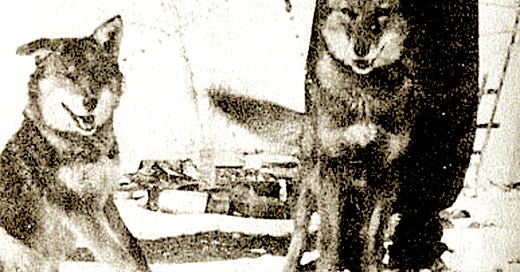coyote lives in Maine
tomorrow calendar spring arrives, but we've still got snow and deer and...
Coydogs?
One winter we found three deer carcasses chewed up in the woods not far from our cabin on various levels of the lot next-door.
When coyotes were first discovered in Maine people were fascinated. They did not know what to make of the mystery, were leaning toward the half- dog half-coyote theory. I read Peter Anderson's IN SEARCH OF THE NEW ENGLAND because ever since I first heard the eerie cry echoing around North Pond, on coming to Maine, I've been interested in learning more. I'd have liked to do a story on them but ended playing on the concept just a bit with the help of John Greenleaf Whittier. I found something of interest on almost every page of Anderson's book.
I learned that the best trapper of coyotes lives only 3 miles away. Anderson traveled throughout New England, checking on coyote lore, science and experience, from Connecticut to Maine. He interviewed biologists, farmers, mathematicians, and woods-men and women. The mathematicians were called on because they had the knowledge of the computerized process called linear discrimination which plotted the measurements of skulls of wolf, dog, western coyote, coydogs, and eastern coyote in an effort to learn about this mysterious canid. As Anderson repeatedly points out, there are no human eye witnesses as to how the coyote, who was not indigenous to this area until lately, got here in the first place.
Apparently just about everything about the eastern coyote would be disputed and the subject was fraught with arguments from various factions: deer hunters, sheepherders, wildlife biologists. The first two blame the coyote for every deer and sheep death, the last claim the canine isn't the nuisance it seems. Anderson found exceptions and deviations to practically everything said about the animal.
How did the eastern coyote become the eastern coyote? Henry Hilton, Maine wildlife biologist, had a pretty good theory. Around the turn of the century a poisoning campaign out west drove the slightly smaller western animal eastward. Wolves were extirpated from the west by poisoned buffalo meat but the coyote learned to avoid the poisoned bait. It also learned to move on. In Ontario, Hilton postulates, many of the coyotes mated with Algonquin wolves, wolves smaller and less prolific than the timber wolf. This hybridization is considered a step of the evolutionary process. The canines mentioned above "have the same chromosome number and can interbreed", gaining genes. The wolf gene in combination with the colder climate and need for larger prey gave the coyote a larger skull. On the mathematician's chart it's located between dog and wolf: 6% longer, 11% wider than the skull of western coyote.
Coyotes are good parents. They mate during mid-January to mid-February and give birth in April or May, usually in an unoccupied den of porcupine or other small animal, after enlarging it. The father does as much for the babies as the mother once they begin the weaning process. The parents regurgitate meals for the young. If regurgitated accidentally out of reach, it is re-swallowed and vomited where the pups can get it. These animals are crepuscular, most active from 4 to 8 AM and from 4 PM to midnight. They prey upon snowshoe hares, other small game and deer; they eat a lot of carrion. Coyotes mark their usually 15 square mile range with scat and urine—the latter individualized, identifying. They're highly adaptable and readily learn to avoid traps. A trapper tells of finding one of his traps dug around and urinated on, "as if to say, 'Piss on your trap'".
Reading this book solved a mystery for me. On one of my walks I found what looked like a porcupine coat lying in the sand on the edge of the woods. All that was left of the critter — a pile of about 25,000 quills and two bones. According to Anderson this is the work of two coyotes. It takes two to disarm the prickly animal and eat it through the belly, cleaning out everything but the quills.
To me the most interesting thing about the eastern coyote is its mysteriousness. I've read the book containing all kinds of knowledge, but still find myself enthralled with the advent and cry of this animal.
There were no witnesses to its remarkable journey, one of the delightful elements in its story. I saw one once in the twilight, hunching beside the road in the weeds watching the lighted vehicle pass. It was wild. Wonderfully wild.
© S. Dorman. Main Metaphor In Winter. Put Out By Wipf & Stock Publishing




